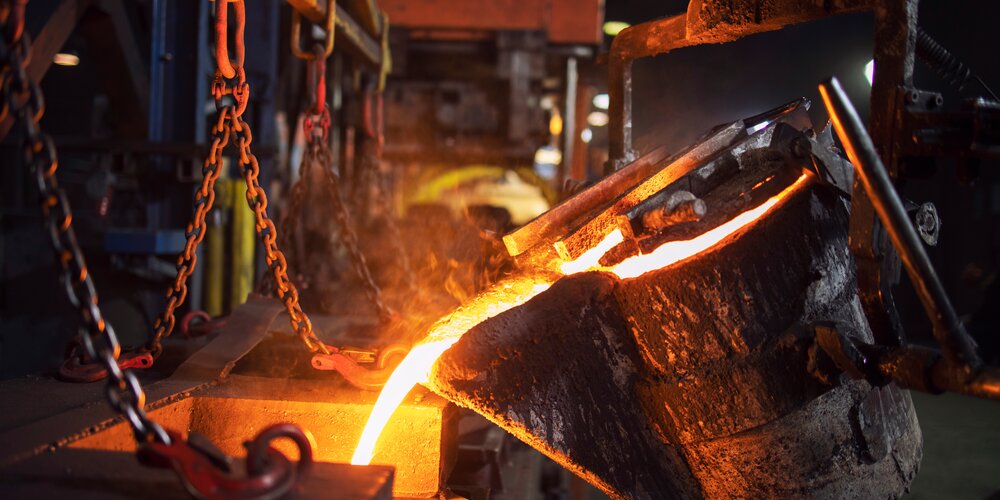
Lifting Equipment in Metal Manufacturing – Safety in High-Heat Environments
Lifting operations within the primary metal manufacturing sector—encompassing foundries, steel mills, and metal processing facilities—are subject to some of the harshest operational environments. High ambient temperatures, abrasive particulates, and the handling of extremely heavy or asymmetrical loads significantly constrain equipment selection and operational safety. It is imperative that lifting equipment remains compliant, operationally fit, and robustly maintained to mitigate unplanned downtime and ensure personnel safety.
Key Challenges in Primary Metal Manufacturing Lifting Operations
High-Temperature Exposure:
Prolonged exposure to elevated temperatures can degrade the mechanical properties of lifting components, including reduced tensile strength in slings, deformation in chains, and softening of polymer-based coatings or sheaths.
Abrasive Operating Environments:
Metal particulates, slag, and steel shards accelerate surface wear on ropes, slings, and lifting points, potentially leading to premature failure or reduced service life.
Heavy, Asymmetric, and Dynamic Loads:
Components such as ingots, billets, molten metal ladles, and fabricated steel structures often possess irregular geometries and weight distributions, necessitating the use of engineered lifting accessories that ensure balanced loading and structural integrity.
High-Cycle Fatigue:
Frequent lifting cycles, particularly in automated or semi-automated handling systems, impose cumulative fatigue stress on lifting systems, increasing the likelihood of microfractures and mechanical fatigue failures over time.
Recommended Lifting Equipment for High-Temperature Operations
Alloy Steel Chains & Heat-Resistant Slings:
Utilize grade 80 or higher alloy chains certified for elevated temperatures. Slings should incorporate high-temperature resistant materials such as aramid fibres or feature thermal insulation coatings to prevent degradation.
High-Performance Crane Ropes:
Use galvanised or thermally protected wire ropes with high fatigue and corrosion resistance. For added durability, consider compacted strand or polymer-impregnated ropes using heat-rated materials such as PTFE, polyimide, or XLPE. Avoid standard plastics like PVC, which degrade under sustained heat.
Load Equalisation & Spreader Beams:
Integrate load distribution beams to minimise stress concentration at lifting points and ensure uniform load handling, especially for large or irregularly shaped metal assemblies.
Inspection & Maintenance Regimes for High-Heat Industrial Facilities
Given the intensified wear factors in metal processing environments, lifting equipment should follow enhanced inspection intervals and rigorous defect identification protocols:
Daily Pre-Operational Checks:
-
Examine lifting gear for thermal degradation, discolouration, loss of cross-sectional integrity, and surface cracking.
-
Assess hardware components (e.g., hooks, shackles) for signs of fatigue or mechanical distortion.
Six-Monthly Thorough Examinations (as per LOLER):
-
Inspection of slings, chains, and auxiliary lifting equipment.
-
Annual equipment that falls under a written scheme of examination and any lifting equipment used for lifting personnel.
Annual Thorough Examinations (LOLER-compliant):
-
Cover all cranes, hoists, and structural lifting components.
Post-Event Inspection Triggers:
-
Conduct immediate inspections following exposure to overload, high thermal incidents, or mechanical impacts.
Written Schemes of Examination (WSE)
In accordance with Regulation 9 of LOLER, lifting equipment used within steel mills and steel manufacturing facilities—especially where high temperatures, heavy loads, and continuous-duty cycles are involved—may require a Written Scheme of Examination (WSE). Equipment such as overhead gantry cranes, ladle handling systems, coil lifters, and magnetic lifting devices are often considered high-risk due to the extreme conditions in which they operate.
The WSE must be compiled and certified by a competent person and should include the following elements:
Defined Scope and Inspection Intervals
Clearly specify which equipment and accessories are covered (e.g. ladle cranes, slab tongs, coil grabs), and establish suitable examination frequencies based on usage and risk exposure.
Critical Component Identification
Detail all components subject to high mechanical stress, heat exposure, or contamination—such as load chains, lifting pins, hydraulic cylinders, lifting magnets, and attachment points. Pay special attention to items exposed to thermal cycling, slag, and dust accumulation.
Appropriate Examination Methods
Define inspection techniques, including visual examination, non-destructive testing (NDT) (e.g. magnetic particle, ultrasonic), and load testing where required to validate structural integrity under operational conditions.
Criteria for Additional Inspections
Outline when unscheduled inspections are required, such as after overload events, near-miss incidents, prolonged exposure to molten metal, or signs of heat-induced fatigue, cracking, or corrosion.
Living Document Status
The WSE should be treated as a dynamic, regularly reviewed document, updated in response to plant modifications, changes in duty cycles, or incident investigations. Reviews should also follow refurbishment, relocation, or changes in environmental exposure (e.g. dust or heat levels).
Operator Competency & Risk Mitigation Protocols
Accurate Load Assessment:
Ensure operators can calculate and verify load weights and centres of gravity using appropriate formulas and lifting charts to prevent overload conditions.
Emergency Response Planning:
Establish formal procedures for managing lifting failures or heat-induced mechanical malfunctions, with emphasis on isolating hazardous zones quickly.
Thermal PPE Standards:
Operators must wear heat-resistant gloves, face shields, and suitable protective clothing rated for radiant and conductive heat exposure during lifting activities in hot zones.
To conclude, lifting operations in metal manufacturing require rigorous engineering controls, specialised equipment, and trained personnel to manage the unique mechanical and thermal stresses present in such environments. Duty holders are legally and operationally responsible for ensuring that all lifting operations are conducted safely, efficiently, and in full compliance with applicable regulations.
Need tailored lifting solutions for your steel plant?
For guidance on specifying heat-resistant, heavy-duty lifting solutions tailored to your environment, contact our technical support team for expert assistance and product recommendations >>> Get in touch today



